|
| Feeding management of milch cattle and buffaloes |
Commonly available feed ingredients for dairy animals |
Cereal grains |
Vegetable protein |
Milling by products |
Animal fat |
Vegetable fat |
|
|
|
|
|
|
|
|
|
|
|
|
|
|
|
|
|
|
|
|
|
|
|
|
|
|
|
|
|
|
|
|
|
|
|
|
|
|
|
|
| Maize or corn (Zea mays) |
|
 |
- Maize has high metabolisable energy value with low fibre content
- It has 8-13% of crude protein.
- It has high TDN of 85%
- Recently, new variety of maize (Floury 2) was produced with high methionine and lysine.
- Farm animals are fed with crushed maize.
- Flaked maize decreases the acetic acid to propionic acid proportion in rumen and hence depresses the butterfat content of milk.
- Improperly stored maize having higher moisture content are prone to aspergillus flavus infestation and produces aflatoxin.
|
| Bajra / Cumbu (Pennensetum typhoides) |
|
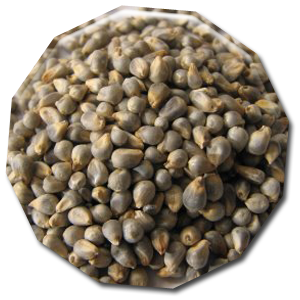 |
- Nutritive value of Bajra is similar to Sorghum
- They have 8-12% of crude protein and rich tannin content.
- Seeds are hard so it has to be ground or crushed before fed to cattle.
|
| Sorghum /Jowar / Milo (Sorghum vulgare) |
|
|
 |
- Sorghum is similar to maize in chemical composition.
- They have higher protein and low fat than maize.
- Cattle are fed with ground Sorghum.
|
|
| Rice (Oryza sativa) |
|
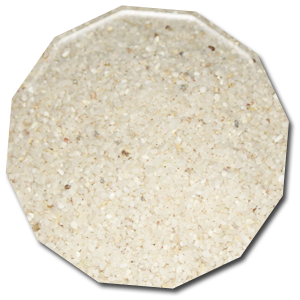 |
- The crude protein and energy values are comparable to maize.
- It is widely used for human consumption.
- Based on the cost, it can be included in animal feed.
|
|
| Oats (Avena sativa) |
|
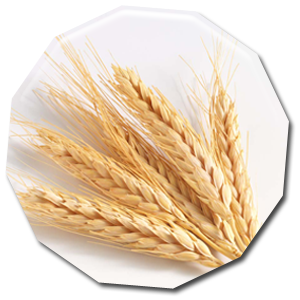 |
- Oats has highest crude fibre of 12 - 16% with 7-15% of crude protein.
- Methionine, histidine and tryptophan are deficient in oats but abundant in glutamic acid.
- Cattles are fed with crushed or bruised oats.
|
| Barley (Hordeum vulgare) |
|
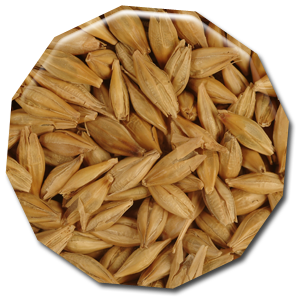 |
- Barley has high fibre content with 6-14% of crude protein
- It has low lysine and less than 2% of oil content.
- Barley is a main concentrate food for fattening animals in UK.
- Verity “Notch 2” developed at UK is rich in lysine.
|
| Wheat (Triticum aestivum) |
|
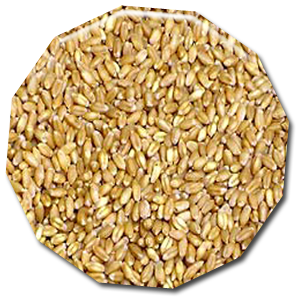 |
- Wheat contains 6-12% of crude protein.
- The endosperm contains prolamin (gliadin) and glutelin (glutenin) protein mixture, which is referred as gluten.
- Strong gluten is preferred for bread making since it form dough, which traps the gasses, produced during yeast fermentation.
- Finely milled wheat is unpalatable to animals because it forms the pasty mass in the mouth and may lead to digestive upset.
- Do not feed finely ground wheat to farm animals.
|
| Groundnut oil cake |
|
- Groundnut oilcake is one of the best protein supplements for livestock feeding and is extensively used.
- Groundnut oil meal refers to solvent extracted residue and two grades (Grade I & grade II) are available in the market.
- Groundnut oilcake refers to expeller pressed and two varieties (Grade I & grade II) are available in the market.
- The common adulterant includes castor husk and Mahua oilcake.
- Groundnut oilcake has about 45% protein, which is deficient in cystein, methionine and lysine, but good source of Vitamin B12 and calcium.
|
 |
Aflatoxin affection
- In rainy season it is specifically labile to contain a toxic factor – Aflatoxins, a secondary metabolite of Aspergillus flavus.
- Mould spoilage and Aflatoxin production can occur at any stage from growing crop to the formulated feed or stored raw material.
- Aflatoxins are the most potent toxic, mutagenic, teratogenic and carcinogenic metabolities produced by the species of Aspergillus flavus and A.parasiticus on food and feed materials.
- Presence of oxygen, conducive temperature (10 – 40ºC) and high humidity favours the mould growth.
- High moisture in the crop, which harvested around wet period and also inadequately dried products, favours the fungal growth and toxin production.
- There are four Aflatoxins, B1, G1, B2 and G2 out which B1 is most toxic.
- The most common symptoms in the affected animals are liver damage with marked bile duct proliferation, liver necrosis and hepatic tumors while the other symptoms include gastritis and kidney dysfunction.
|
| Soybean meal |
|
- Soybean meal contains 44% proteins with all indispensable amino acids except cystein and methionine since the concentrations are sub optimal.
- It can be fed to all livestock up to 30% of the ration.
- The common adulterant includes castor husk and Mahua oilcake.
- Like other oil seeds, raw soybeans have number of toxic and inhibitory substances.
- These toxic, inhibitory substances and other factors in soybean like saponins can be inactivated by proper heat treatment during processing.
|
 |
| Sunflower oil cake |
|
- Sunflower oilcake contains 40% of protein with low lysine and twice the amount of methionine than soy protein.
- It has very short self-life.
- The expeller variety of Sunflower seed meal or cake has high content of polyunsaturated fatty acids, when fed in large amount to cows it makes butter soft.
- It can be fed to cattle ration up to 20% level.
- Sunflower oilcake is not recommended for calves.
|
 |
| Cotton seed meal |
|
- It has a good quality of protein but with low content of cystein, methionine and lysine.
- The calcium to phosphorous ratio is about 1:6, so calcium deficiency may occur.
- Lactating cows can be fed with cotton seed meal but when it was given large amount, milk may become hard and firm, so butter made from such milk fat is difficult churn and may also tend to develop tallow taints.
- Both decorticated cottonseed oilcake as well as undecorticated cottonseed oilcake are available in the market with two grades (Grade I & II) in each varity.
- Cottonseed meal contains 0.3-20g/kg dry matter of a yellow pigment known as Gossypol, a polyphenolic aldehyde.
- It is an antioxidant and polymerization inhibitor.
- It is toxic to simple stomached animals and the symptoms include depressed appetite, loss of weight and even lead to death due to cardiac failure.
- Gossypol toxicity can be reduced by the addition of calcium hydroxide and iron salts.
- Shearing effect of screw press in expeller process is an efficient gossypol inactivator.
|
 |
| Coconut meal |
|
- It contains 20-26% crude protein with low lysine and histidine content and 2.5-6.5% oil content.
- The higher oil meals tend to get rancid and may cause diarrhoea; hence low oil content meal should be preferred.
- It should be restricted to swine and poultry as it contains low protein and high fibre and low fibre coconut meal can be fed to monogastric animals with lysine and methionine supplements.
- Coconut meal produces firm milk fat that is most suitable for butter making.
|
 |
| Linseed meal |
|
- Linseed is rich protein source with low methionine and lysine content and also rich in phosphorous part of which is present as phytase but has only moderate calcium content.
- It is a high source of vitamins like riboflavin, nicotinamide, pantothenic acid and choline.
- It also has protective action against selenium poisoning.
- Linseed oil meal refers to solvent extracted residue and two grades (Grade I; grade II) are available in the market.
|
- Among the oilseed residues linseed is unique because it readily dispersible in water, forming a viscous slime due the presence of 3-10% of mucilage.
- Cyanogenetic glycoside, linamarin and an associated enzyme, linase in immature linseed hydrolyses it with the evolution of hydrocyanic acid.
- HCN is a potent respiratory inhibitor and hence, depending on the species the minimum lethal dose taken orally has been estimated as 0.5-3.5 mg/kg of body weight.
- Proper water washing, drying and storage can reduce glycosides in the feedstuffs.
- Linseed oilcake refers to expeller pressed and two verities (Grade I; grade II) are available in the market.
- Linseed oilcake/meal is a good food to ruminants.
|
|
 |
| Mustard cake |
|
- It is widely used cattle feed in Northern India.
- Its nutritive value is lesser than groundnut cake.
- D.C.P and T.D.N values are 27% and 74 % respectively.
- It can be included up to 10% of the ration;
- It has rich calcium and phosphorous content of about 0.6% and 0.1% respectively.
|
| Sesame seed meal / Gingelly oil cake / Til oil cake |
|
- It contains 40% protein, rich in leucine, arginine and methionine but low lysine.
- It was produced from the residues of sesame meal after removal of oil from sesame seed.
- There are three verities – red, black, white.
- White is of high nutritive value than red.
- It has high phytic acid.
- Sesame seed meal has laxative action and can be included in the cattle ration upto 15%.
|
| Rice bran |
|
- It is the outer coarse coat of the rice grain separated during processing.
- Rice bran is a valuable product with 12-14% of protein and 11-18% oil mostly with unsaturated fatty acids and hence it becomes rancid rapidly.
- The oil removed rice bran is available as deoiled rice bran in market for livestock feeding.
|
| Wheat bran |
|
- Wheat bran is an excellent food with more fibre content.
- It is laxative when mashed with warm water but tends to counter act scouring when it was given dry.
- It is not commonly fed to pigs and poultry because of the fibrous nature and low digestibility.
|
| Polishing |
|
- During rice polishing this by products accumulates which contains 10-15% protein, 12% fat and 3-4% crude fibre.
- It is rich in B- complex and good source of energy.
- Due to high fat content rancidity may occur.
|
| Molasses |
|
- It is a byproduct produced during juice / extract prepared from selected plant material.
- It is a concentrated water solution of sugars, hemicelluloses and minerals.
- Four varities of molasses are commonly available viz. cane molasses, beet molasses, citrus molasses and wood molasses.
- Cane molasses is a product of sugar industry and contains 3% protein with 10% ash.
- Beet molasses is a product during production of beet sugar and has higher protein (6%).
- Citrus molasses is bitter in taste with highest protein (14%) and produced when oranges or grapes are processed for juice.
- Wood molasses is a product of paper industry with 2% protein and palatable to cattle.
- Molasses is a good source of energy and an appetiser.
- It reduces dustiness in ration and is very useful as binder in pellet making.
- Molasses can be included upto 15% in cattle ration.
|
- Fat (Vegetable/Animal) provides 2.25% more energy than carbohydrate or protein.
- Oil and fat reduces the dustiness in feed and lessens the wear on feed mixing equipments.
- Vegetable oil like corn oil, Groundnut oil, sunflower oil and animal fat like lard, tallow are extensively used in livestock feeding.
- Animal fat contains saturated as well as unsaturated fatty acids of C20, C22, and C24.
- Vegetable fats contain greater proportion of linoleic acid.
- Higher level of poly unsaturated fatty acids leads to rancidity and therefore anti oxidants like Butylated hydroxytoluene (BHT) or Ethoxyquin should be included in high fat diet.
|
- Feed alone constitute 60 per cent of the production cost of milk. Hence, feeding management play a vital role in farm economy.
- The nutrient requirement should be determined for maintenance as well as for milk production and to meet the fat percentage in milk and gestation.
- Based on the nutrient requirement ration should be computed.
- In general the dry matter from roughage should not exceed 2 per cent of cow’s live weight nor should it be less than 1 per cent
|
| Feeding dairy cow at different stages of lactation |
|
- Under practical feeding condition it is not possible to select much among the roughages or vary the ingredient in concentrate mix.
- The farm manger should carefully plan a cropping programme to ensure year round supply of mixture of leguminous and non leguminous forages.
- One feeding schedule based on thump rule is
Stage of lactation |
Quantity of green grass to be give (kg) for animal weighing |
Concentrate ( kg) |
250 kg |
300 kg |
350 kg |
Dry cow |
25 |
30 |
35 |
- For non-pregnant cows no concentrate is required.
- Pregnant cows should be fed additional quantity of 1.5 kg of concentrate from 7th month of gestation
- In case of dry cow, allowance up to 1 kg concentrate can be given if the condition of cow is poor or the fodder quality is inferior.
|
Milch cow |
25 |
30 |
35 |
- 1.0 kg for every 2.5 kg of milk of average 4% fat percentage, in case of buffalo 1.0 kg for every 2.0 kg of milk produced.
|
|
| |
Early lactation |
- The recently calved high producing cow is unable to eat enough feed to support her milk production.
- This means that the cow should have enough reserve to store nutrient to be drawn to tide over the period of heavy demand in early lactation, during which period the cow loses weight.
|
| Challenge feeding |
|
- Challenge feeding means the cow with high milk production potential are to be fed increase quantity of concentrate to ‘challenge’ them to produce to the maximum.
- This starts two weeks before expected date of calving. This challenge feeding will condition her digestive system for the increased amount of concentrate and provide enough nutrients to initiate lactation on a higher plane.
- Two weeks before the expected date of calving start feeding 500 g of concentrate mixture.
- The quantity should be increased daily by 300-400 g until the cow is consuming 500-1000g concentrate for every 100 kg body weight.
- After calving, the concentrate allowance should be increased by 500 g per day in the first 2 weeks of lactation until the cow achieves peak yield somewhere in the second month of lactation on free choice basis.
- After this the milk yield is tested and the concentrate allowance is fixed accordingly.
Challenge feeding schedule:
Sl.No |
Period |
Concentrate allowance |
1 |
Last 2 weeks before calving |
Starting from 500g, increase 300 - 400g daily until the cow is eating 500 – 1000g per 100kg body weight. |
2 |
First 2 weeks of lactation |
Increase 500g per day to free choice level. |
3 |
Second week to peak yield (test day) |
Free choice |
4 |
From test day onwards |
According to production as per thumb rules. E.g. 1Kg for every 21/2 kg milk produced |
5 |
Remaining lactation |
Concentrate adjusted to monthly test of milk Production |
6 |
All periods |
Green fodder and dry fodder given adequately |
|
| |
Feeding during mid and late lactation |
- The nutrient deficit period of early lactation is followed by a relatively stable period during which the cow can consume enough feed to meet the various demands for nutrients and the body weight of the cow remains more or less stable.
- During this period the cow maybe fed a well balanced ration of god quality fodder and concentrate according to the milk yield and fat percentage of milk.
- During the late lactation, intake ability of the cow exceeds nutrient needs. This is the time when the cow starts needing extra allowance for the growing foetus.
- This is also the period when the cow can readily replenish the already depleted body reserve and gain weight very fast.
- From 7 ½ month to 10 months of lactation, cow may be fed 1-2 kg concentrate feed in addition to their nutrient requirement for maintenance and milk production to replenish the condition lost in early lactation.
|
| |
Feeding high producing dairy cows |
- High producing dairy cow should eat a large volume of nutrient daily to sustain th milk production at that level.
- This is simply not possible with bulky forages alone due to physical limitation of volume intake (space in the rumen).
- If high level of concentrate is fed it may change the microbial and chemical atmosphere of the rumen and cause dysfunction.
- Rumen fermentation can be controlled by a) composition of ration b) ratio of ingredients in the ration c) quantity of feed supplied d) frequency of feeding and e) physical form of feed.
- For a high producer the forage fed should of superior quality which also reduces the quantity of concentrate required.
- Crude fibre is very important in the ration of milking cow because it is well known that rumen fermentation leading to acetic acid production is dependent on the percentage of cellulose in the ration.
- Cows need acetic acid for maintaining normal milk fat percentage as well as total milk production.
- Ruminant ration should contain a minimum of 20-25 per cent crude fibre.
- Higher percentage of grain in the ration reduce cellulose digestibility and cause disturbances like depressed milk fat, depressed milk production and in extreme cases damage to the rumen wall, development of acidosis and death.
- Frequency of feeding: dividing the daily ration into 3 or 4 parts and feeding them in so many installments has been found to be useful in overcoming this problem.
- This also results in greater digestibility and better utilization of protein apart from preventing explosive release of acids.
- A high concentrate ration induces less amount of saliva flow compared to roughages.
- But when feed is given in 4 or 5 installments the proportion of Na and K salts in rumen return to normal.
lactation.
|
op
- More than half of the calf’s foetal growth takes place during the last quarter of pregnancy-the dry period.
- Feeding of cow during this period is often neglected because the cow is not returning anything in terms of milk.
- Due to this reason, good fodder and concentrates are generally withheld from the dry cow. This will have adverse consequences on her future production.
- A dry cow should be fed adequate quantity of well balanced ration for
Maintenance of the cow
Forming sufficient reserve for ensuing lactation
Growth of foetus
Production of colostrum with high nutritive value.
- The condition of the cow can be controlled by feeding extra nutrients during the latter part of lactation or during dry period.
- If the condition of cow is poor, the quantity of concentrate should be increased.
- During dry period a weight gain of 20-25 kg for smaller cows and 30-40 kg for larger cows should be ensured.
- A cow produces only 10-15 kg of dry matter in the foetus, foetal membranes and fluids. This is equivalent to 50-100 kg of milk production.
- Thus it is the requirement for the replenishment of body reserve that constitute the major additional requirement of dry cow, not foetal development.
- The cow can be made to regain condition either during late lactation or during dry period.
- It has been found that the former is better because of the following reasons.
- The efficiency of feed utilization for weight gain is better during late lactation than dry period.
- Many of the problems resulting in ketosis, displaced abomasum, fatty liver, retained placenta, prolapse etc. can be minimized by restoring to all roughage feeding during the dry period.
- The roughage should be tough enough to stimulate and restore rumen muscle tone.
- If the cow is in poor condition at drying off, she should be given extra concentrate to regain condition.
|
| |
Mixing of concentrates and roughages |
- Traditionally, concentrate are fed at the time of milking. Roughages re offered either before or after milking.
- In high producers, when concentrates are fed in heavy doses at milking time, the appetite of the cows will be reduced temporarily and they may not eat roughages for some time.
- Consequent, there will be 4 different fermentation, two primarily due to concentrate and two primarily of roughages.
- The feeding of concentrates separately from roughages during a four time feeding schedule reduces acidic acid production and increases propionic acid.
- It has been observed that feeding grain on top of silage increased the fat percentage of milk production.
- Feeding concentrates either on top of forages or mixed with forages has been four to favour optimum rumen fermentation.
- This has led to the concept of complete feeds which incorporates both roughages and concentrates.
|
| Complete feeding |
|
- In order to simplify feeding of dairy cows complete diet system have been introduced.
- Complete diet is an intimate mixture of concentrate and roughages in a desired proportion processed in such a way as to preclude selective eating. It forms the sole source of food for the cow.
- It reduces labour requirement and keeps a tighter control on the cow’s nutrition.
- It also facilitates the application of least cost method of ration formulation.
- Feeding of complete diet ad libitum to dairy cow has been found to be advantageous in that it increases feed intake, preserve milk quality as result in better utilization of nitrogen.
- These are in addition to the most obvious advantage of prevention acidosis from over-eating of concentrate by high producer.
- The complete diet feeding system is radically different from conventional feeding method in that there is no individual approach in feeding cows.
- Group feeding is practiced in complete feeding system. There are also fewer changes in diet formulation according to the milk yield.
- This has come as a result of the experimental and practical feeding observation that yield and efficiency are not improved by individual rationing compared to flat rate feeding of cows grouped according to milk yield or stage of lactation.
|
| |
Guidelines to feed high yielders |
- Ratio of a diary cow should contain minimum 20-25 per cent dry matter forages.
- In the case of high yielder, the forages given should be of superior quality.
- It should be cut at the proper state of maturity (45 days). 30 % to 50 % per cent of roughages should be of leguminous crops.
- Processing and reducing the forage to smaller bits may be avoided except in case of very coarse fodder.
- For high yielder when large quantities of concentrates are to be fed, it should be either fed immediately after feeding roughages or preferably, it may be fed mixed with the roughages.
- To ensure proper nutrient intake of roughage3 concentrate ration, a density x digestibility value of 35 may be maintained.
- The feeding schedule should be such that it maintains a continuous fermentation in the rumen.
- The cow should be fed a minimum of 4 times a day, each feeding comprising of both concentrate and roughages.
|
Top |